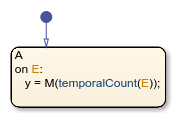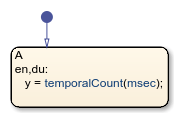temporalCount
事件数、图执行次数或自状态激活以来的时间
描述
示例
提示
您可以使用引号将关键字
'tick'、'sec'、'msec'和'usec'括起来。例如,temporalCount('tick')等效于temporalCount(tick)。每当关联状态重新激活时,Stateflow 图都会重置
temporalCount运算符使用的计数器。绝对时间时序逻辑运算符的计时取决于 Stateflow 图的类型:
Simulink 模型中的图根据仿真时间定义时序逻辑。
MATLAB 中的独立图根据挂钟时间定义时序逻辑。
计时上的差异会影响图的行为。例如,假设此图正在执行状态
A的entry动作。
在 Simulink 模型中,对
f的函数调用在单个时间步中执行,不会增加仿真时间。调用函数f后,图将零值赋给y。在独立图中,对
f的函数调用可能需要几秒的挂钟时间才能完成。调用函数f后,图将状态A变为激活状态后经过的非零时间赋给y。
版本历史记录
在 R2008a 中推出


